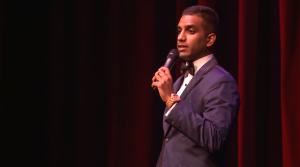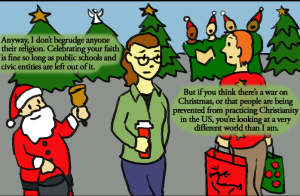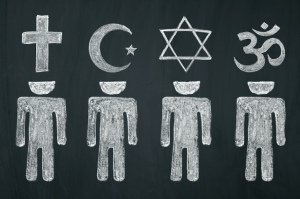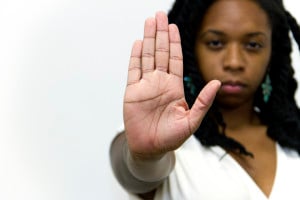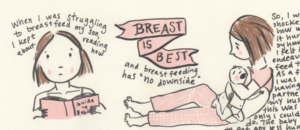Picture this: You’re fed up with being the target of street harassment.
If you’re a woman, queer, trans, and/or gender non-conforming, it’s probably not hard to imagine. Just think of one of those days when you’ve gotten too many unsolicited comments on your appearance, too many requests to “smile,” too many strangers who feel entitled to your space, time, and image.
So you’re venting to a friend, when along comes a man to explain that these strangers were just trying to be nice, and you “need to learn to take a compliment.”
How would you feel? Insulted? Pissed off? Like you wish this guy would stop assuming he knows your own experience better than you do?
You’re probably saying yes. There’s a good chance that you’re saying, “This shit happens to me all the time, and I wish it would stop!” And you might find comfort in knowing that there’s a word, mansplaining, to describe the common and frustrating occurrence of men interrupting and explaining things to women and people of other genders.
I’ve been there, too.
And unfortunately, just as frequently, I’ve had white people try to explain racism to me, a woman of color. There’s a word for this phenomenon, too – whitesplaining. It’s incredibly frustrating to share my experiences with racism, only to have a white person try to speak over me about it – and often by belittling how racism hurts me.
If you’re white, you may have whitesplained without realizing it. To understand whitesplaining, now picture yourself in the following situation.
I’m venting about my day, and I tell you I’m angry that a white neighbor told me, “I don’t even see you as Black.”
Would you reassure me that my neighbor meant well? If you do, don’t be surprised if I’m just as annoyed as you would be if a man tried to explain your experience with street harassment to you.
Usually, signs of whitesplaining include a condescending tone and a paternalistic assumption that a person of color doesn’t know enough to accurately articulate their own experience.
The term doesn’t apply to every instance when a white person talks about racism, just like mansplaining doesn’t apply to every instance when a man talks about gender oppression. But whitesplaining is a result of the power white people hold as part of the dominant culture in the US. So recognizing when it’s happening is one of the everyday ways you can help dismantle the oppressive system of white supremacy.
Like with other forms of privileged explaining, including mansplaining, people who whitesplain have been conditioned to believe that they’re somehow more qualified to speak about a marginalized group than a person who belongs to that group.
That’s why there’s no equivalent like “blacksplaining.” When a Black person talks about race with a white person, they don’t have the same institutional power as a white person who belongs to the dominant culture.
And that’s the problem with whitesplaining. It’s not just harmlessly discussing racism, but implicitly acting on racist ideas that say that people of color are ignorant and wrong, even about their own experiences.
You probably don’t think you’re motivated by racist ideas when you whitesplain – just like men don’t have to hate women in order to participate in everyday sexism like mansplaining.
For instance, you might think you have a perfectly good reason for telling me my neighbor didn’t mean to be racist. You’ve spent time with her, and you’ve never known her to be racist, or you can tell she meant to compliment me by saying she doesn’t see me as Black.
But while these well-meaning reasons for correcting me feel true, it’s also true that you can act on subconscious, implicit biases leading you to dismiss what I have to say because I’m Black.
If you don’t believe whitesplaining is wrong, then you’re missing how the motivation behind whitesplaining is influenced by white supremacy. So let’s unpack the most common reasons why whitesplaining happens, to examine why it’s so misguided.
1. You Think I’ve Got a Fact Wrong (‘Actually…’)
For many people, it’s tempting to speak up when you encounter a fact you believe is wrong. Correcting someone seems pretty straight forward – so does it really relate to racism?
In certain cases, it does. And if you’re a white person talking with a person of color about racism, it’s best to keep this possibility in mind.
Because of white supremacy, many white people – especially white men, who are also influenced by patriarchy – have been conditioned to speak over other people and dominate spaces.
This begins as early as elementary school, when white and male students get more positive encouragement like being called on more often, even when they’re not raising their hands.
If you’re used to being affirmed for sharing your thoughts, you might feel entitled to share them even when – no offense – you have no idea what you’re talking about.
And then you might do one of the most irritating forms of whitesplaining – assuming a person of color just doesn’t understand what’s going on.
I’ve experienced this too many times when white folks believe they know more about what I’ve been through than I do – through secondhand information or just their own wild guesses.
For instance, when I tell someone that saying, “I don’t see color” erases my identity, they often dismiss my complaint with any of number of reasons they didn’t mean to hurt me.
Believe me, I’ve heard them all: “Actually, I didn’t mean it that way. I’m just trying to say we’re all human. I’m trying to say I don’t see you as different. I’m trying to treat everyone equally.”
Try as they might, they’re not going to achieve equality by taking a “colorblind” approach. Explaining that you have good intentions doesn’t erase the impact of invalidating my racial identity and implying that seeing my Blackness is a bad thing.
Talking with me about issues that affect my community means you have limits – you don’t have a lifetime of firsthand experience.
So it’s simply a sign of respect to give me the benefit of the doubt and trust that I can find the words for my own experience.
There’s nothing wrong with clearing up information if you come across something you believe is incorrect. But approach the situation with some humility. Ask questions to figure out why there’s a difference between what I’m saying and what you believe is true.
You might find that your information is wrong, that I interpret it differently, or that we’re on the same page, but I use different language rooted in my experience. And you’ll probably learn something new.
2. You Think My Feelings Are Wrong (‘Be Objective, It’s Not That Bad…’)
Have you ever felt like a person of color was being “oversensitive” when they got upset about racism?
If you try to tell me I shouldn’t be emotional about a racial justice issue, then I already know you don’t understand that issue. Because emotion is a natural response to oppression – and having someone judge how I feel about it just makes me feel worse.
For example, take microaggressions – small, subtle incidents of racism often done by people who don’t know they’re being racist. An example is someone telling me, “You’re pretty for a Black girl.”
It’s not the most egregious expression of racism, so you may wonder, “What’s the big deal?”
I’m upset, you’re confused, and the difference between our reactions isn’t just a matter of my being “oversensitive.” It’s a matter of privilege: You can learn about racism through secondhand sources, while I’ve directly experienced racism my entire life.
So it’s not up to you to decide what I should be offended by. Save your whitesplanation if you want to explain why I’m overreacting to a well-meaning compliment (which isn’t a compliment at all) by cringing at “you’re pretty for a Black girl.”
After I’ve dealt with microaggressions on a daily basis for so long, it’s just cruel to expect me to minimize my feelings about racism.
But wait – do my feelings make me biased? Maybe you want to have an “objective conversation,” a “rational debate,” without emotions getting in the way.
Like so many whitesplainers, you believe what you say is important because you have logic on your side. Objectivity is an understandable goal, but think about what it means to believe you’re the only one who can bring “reason” into the conversation.
The truth is that you’re just as biased as anyone else – your perspective is influenced by your own experiences and position of privilege. That also gives you a biased point of view on what “objectivity” means.
You’re approaching the conversation like a high school debate, as if this is just a harmless exercise in flexing our reasoning skills.
But when we’re talking about racial injustice, we’re actually addressing real issues with a negative impact on real people’s lives.
This isn’t the time to show off your debate skills just for the hell of it, or to play “devil’s advocate” when all you’re really doing is upholding the status quo. The phrase “the devil doesn’t need an advocate” comes to mind – since you’re siding with the dominant norm of white supremacy.
It’s tempting to wave around your “rational thought” that you think invalidates my feelings – but you’re not an authority on how I should feel about the issues that affect me.
3. You’re Concerned About My Approach (‘I Think What You Mean Is…’)
Whitesplainers are supposedly full of concern when they say I’d be better off, or a better advocate for racial justice, if I just said or did things differently.
For instance, have you ever felt the need to point out that a person of color was “generalizing” white people when they talked about racism?
If I say, “White people talk over me,” you might jump in with: “Not all white people. More people would listen to you if you didn’t generalize.”
And sure, I could amend my statement to: “Some white people talk over me. But not all of them. I know white people who don’t talk over me at all. And I’m sure the ones who do it don’t realize what they’re doing, and they don’t mean to be racist.”
Except there’s actually a problem with rushing to say that “not all white people” are part of the problem of white supremacy.
If I focused on reassuring every white person that they’re not personally responsible, then nobody would get the chance to examine how they might contribute – whether it’s by interrupting people of color, paying more attention to white folks who speak, or internalizing and benefiting from society’s messages that white people have more important things to say.
Your attempt to make sure I get the right message across may come from a good place. But the thing is – and do forgive me if this comes across as “generalizing” – people who whitesplain so often get things wrong, or at the very least, they miss the point.
It’s true that not every white person speaks over people of color – but blaming all white people for this phenomenon isn’t even the purpose of what I’m saying. If you don’t derail me to focus on protecting white people’s feelings, we could get to the real point of the problem – and what to do about it.
4. You Think You or Someone Else Is Being Falsely Accused (‘But I’m Not a Racist!’)
Speaking of derailments – when I’m talking about a racist act, I don’t have much interest in whether or not the person responsible is “a racist.”
If that sounds counterintuitive, then you could really use this clarification about addressing white supremacy: It’s not about identifying people as racists.
It’s also not about “bashing” white people – but you may interpret it that way if you’re feeling uncomfortable. And then you might whitesplain that people of color are “attacking” you for no reason.
When it comes to things like holding implicit biases and benefiting from white privilege, the question of whether or not someone is intentionally bigoted is completely irrelevant.
So you’re not under attack if a person of color is talking to you about race – not even if they’re calling you out for racism.
I remember one call-out in which writers of color let a white editor know how he’d contributed to racism in the publishing industry, and how he could do better.
Because it’s such a sensitive topic, many people interpret any mention of racism as a conflict – and this discussion was no different.
The editor’s friends immediately rallied to his defense, saying, “He doesn’t have a racist bone in his body!”
But nobody had even said this man was “a racist.” We simply pointed out that his actions had a harmful impact – and his being a good person wouldn’t make that impact vanish.
If you’re called out for racism and you take it as a personal attack on your character, you’re making the situation all about you – not the bigger picture of how all of us can take responsibility for our own role in white supremacy.
Your belief that someone “doesn’t have a racist bone in their body” can lead you to overlook the impact of what they’ve done and focus instead on their intentions.
In other words, you’re oversimplifying the issue, separating yourself from “the bad guys” and saying good people can’t possibly do something wrong.
Unfortunately, good people contribute to white supremacy every day – and if you can’t face the ways white supremacy influences your life, you’ll never be able to change it. That means you’ve got to stop focusing on your good nature and intentions, which has you prioritizing your feelings over people of color’s pain.
You’d have a much more positive impact if instead, you focused on addressing our very real, very valid concerns about how you’re contributing to our oppression.
So rather than whitesplaining the why of insensitive actions, try stepping back and listening to what only a person of color could tell you – how the actual impact of racist actions affect them.
If that makes you uncomfortable, it’s time to practice sitting with and learning from your discomfort instead of assuming that it means you’re under attack.
5. You Heard Another Person of Color Say Something Different (‘That’s Not What I Heard…’)
Listening to people of color is a great way to learn about racism. But please don’t just carry our quotes around like weapons to use against other marginalized folks.
Too many white people use this tactic to tell us that we’re wrong about racism – citing the Native friend who doesn’t mind cultural appropriation, or the Black celebrity who disagrees with Black Lives Matter protesters.
For instance, during Baltimore protests of the death of Freddie Gray, CNN’s Wolf Blitzer told activist DeRay McKesson, “I just want to hear you say there should be peaceful protests, not violent protests, in the tradition of Martin Luther King.”
Blitzer’s not the only one to take King’s words out of context to criticize police brutality protesters. This common trend shows exactly what’s wrong with using people of color’s words this way.
For one thing, Black people are not a monolith. We’re allowed to disagree. And your whiteness doesn’t grant you the authority to determine which one of us is right.
Because he advocated non-violent action, many people point to church-going, suit-wearing Dr. Martin Luther King, Jr. as a symbol of how Black folks “should” behave – conveniently forgetting that King was assassinated for his beliefs and leadership.
Using King in this way also oversimplifies his life and his message – his words on riots actually show that he doesn’t condemn them as “misbehavior.”
He actually says: “As long as America postpones justice, we stand in the position of having these recurrences of violence and riots over and over again. Social justice and progress are the absolute guarantors of riot prevention.”
To understand violent riots, you have to understand the unjust conditions that create them.
And if you actually listen to people of color instead of exploiting our words to confirm your own biases, you can learn a lot more about our diverse experiences.
6. You Want Me to Stop Talking About Racism (‘You’re Being So Divisive’)
Let’s face it – there are several excuses for whitesplaining, from hurt feelings to so-called “concern,” but many people who whitesplain do it simply because they don’t want me to talk about race.
“You’re being divisive.” “We should be uniting.” “There’s no such thing as race – we’re all human!”
Whitesplaining is particularly dangerous when it’s used to shut down conversation and action against racism.
For instance, you might explain that you don’t disagree with the message of Black Lives Matter, but you think the phrase should be “all lives matter,” because that captures the fact that everyone deserves to be safe from violence.
This isn’t just a matter of harmlessly sharing your opinion about an issue of race. You’re spreading a perspective that comes from the privilege of being silent in the face of injustice.
There is an urgent need to protect Black people from a criminal justice system that doesn’t value our lives, and you’re dismissing a whole movement aimed at doing just that.
Right now, we don’t need your interrupting to remind us that white people matter, too. There are white people who have also been mistreated by police, and that’s not okay – but it doesn’t invalidate the fact that we need to address the racial bias that has people of color targeted by police violence at much higher rates.
It doesn’t change that people believe racist stereotypes about Black people as “thugs,” exonerate police officers who attack people of color, and find any number of reasons to blame the victim. It doesn’t erase this horrific example of institutional racism that treats Black lives like they don’t matter at all.
If you understood my life experience, you’d know why recognizing race and directly addressing racial injustice matters to me.
Here’s the Key to Avoiding Whitesplaining
Reading this all at once might give you the impression that avoiding whitesplaining is a complicated matter.
Holding back from correcting someone when you think they’re wrong, sitting with uncomfortable emotions when you feel like you’re under attack, stepping back when you think you could explain something better – all of this takes some self-control.
There’s one strategy that will help you figure it all out: Approach racial justice conversations with humility.
In all of these examples I’ve shared, white people think they’re telling me something that’s never occurred to me before.
But the thing is, I’ve heard these whitesplanations over and over again. None of them are original, and it’s a waste of my time (and yours) to do this dance again and again and treat them like they are.
It’s also arrogant and condescending to assume that you and I see things differently simply because you’ve got all the answers and I lack the capacity to understand my own experience.
It’s all a perfect example of what you’re missing when you think I need you to explain things to me.
Whether you want me to “calm down” so I get my message across, to clarify what I mean so I don’t hurt white people’s feelings, or to stop talking about race so you feel more comfortable, whitesplaining is not the answer.
Because regardless of your intentions, whitesplaining has a damaging impact – silencing people of color, shutting down vital racial justice conversations, and often spreading misinformation.
So rather than upholding an oppressive lie that says people of color need white saviors in order to have reasonable conversations, have some humility. Recognize that you don’t have all the answers, and people of color deserve space to be heard without white people talking over us.
[do_widget id=’text-101′]
Maisha Z. Johnson is the Digital Content Associate and Staff Writer of Everyday Feminism. You can find her writing at the intersections and shamelessly indulging in her obsession with pop culture around the web. Maisha’s past work includes Community United Against Violence (CUAV), the nation’s oldest LGBTQ anti-violence organization, and Fired Up!, a program of California Coalition for Women Prisoners. Through her own project, Inkblot Arts, Maisha taps into the creative arts and digital media to amplify the voices of those often silenced. Like her on Facebook or follow her on Twitter @mzjwords.
Search our 3000+ articles!
Read our articles about:
Our online racial justice training
Used by hundreds of universities, non-profits, and businesses.
Click to learn more









